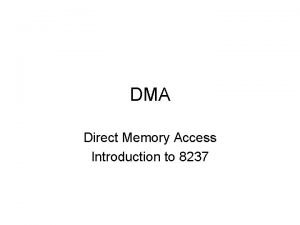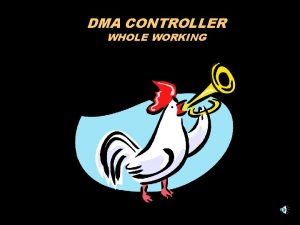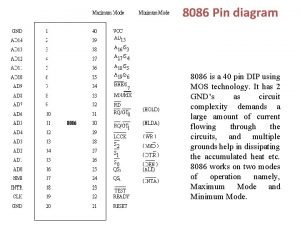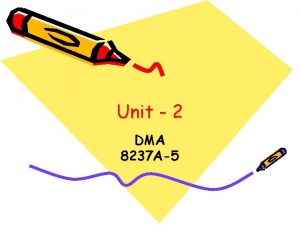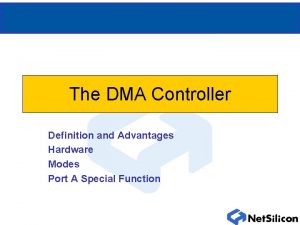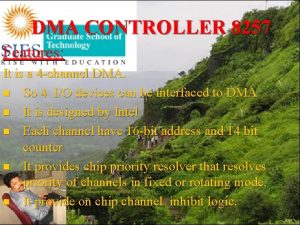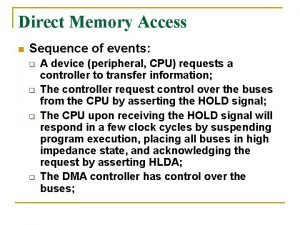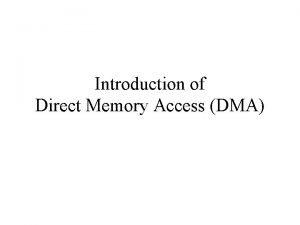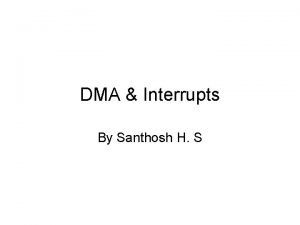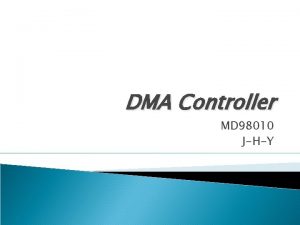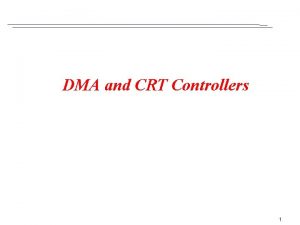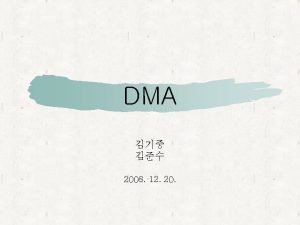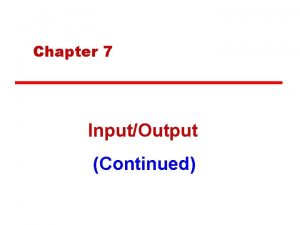DMA CONTROLLER WHOLE WORKING 8237 DMA Controller 8237







![8237 USER ACCESSIBLE REGISTERS ADDRESS [CS + ? ] REGISTER R/W 0 1 2 8237 USER ACCESSIBLE REGISTERS ADDRESS [CS + ? ] REGISTER R/W 0 1 2](https://slidetodoc.com/presentation_image_h2/4f8ad8033810ba8fd33c6d8dbb5d3213/image-8.jpg)








- Slides: 16

DMA CONTROLLER WHOLE WORKING

8237 DMA Controller

8237 DMA Controller Summary • Direct Memory Access means that the microprocessor is not involved in the transfer of data • The 8237 takes control of the address and data bus and facilitates the transfer of data between an I/O device and memory or between memory and memory • Realize that the only time one really needs the CPU is in decoding and executing instructions

8237: The Devil’s in the Details! • The DMA process starts with a request (DREQ) from a peripheral • The 8237 in turn requests the CPU (HRQ) to kindly get out of the way • The CPU responds with hold acknowledge (HLDA) and relinquishes control of the data bus and the address bus • The 8237 in turn acknowledges to the peripheral that the DMA will shortly be underway

8237 Pin Functions. . . • D 0/A 8 - D 7/A 15 These are multiplexed lines that supply data as well as the MSB of the 16 -bit address. The rest of the address bits are provided by the processor into a page register • A 0 - A 7 During DMA these lines provide the LSB of the 16 -bit address. During configuration of 8237, A 0 -A 3 are used by the CPU to address the internal registers of the 8237 and A 4 -A 7 are disabled • ADSTB This output from the 8237 is used to demultiplex the MSB of the address from the data. ADSTB goes high to indicate valid address on the multiplexed data/address lines D 0/A 8 - D 7/A 15

Inside the 8237. . . • There are 4 DMA channels. For each channel there are two 16 -bit address registers. One holds the base address (initial address). As the DMA cycle gets underway, the address changes to point to the current location. This is held in the current address register. • The count registers hold number of bytes of data that must be transferred. All four channels can transfer data between I/O and memory • For memory to memory transfers channels 0 and 1 are used and channel 0 is always the source and channel 1 is the destination.

Many modes. . . many moods! • There are four modes of DMA transfer. The single mode transfers one byte of data • In block transfer, the number of bytes programmed in the count register is transferred unless EOP occurs prematurely • Demand transfer is similar to block transfer with the additional feature that the peripheral can stop DMA by deactivating DREQ • Cascading is not a mode per se but applies to a situation, as in the PC, where the slave's HRQ is connected to the DREQ of the master and the slave's HLDA is connected to the DACK of the master. That particular channel of the master is then programmed to be in the cascade mode
![8237 USER ACCESSIBLE REGISTERS ADDRESS CS REGISTER RW 0 1 2 8237 USER ACCESSIBLE REGISTERS ADDRESS [CS + ? ] REGISTER R/W 0 1 2](https://slidetodoc.com/presentation_image_h2/4f8ad8033810ba8fd33c6d8dbb5d3213/image-8.jpg)
8237 USER ACCESSIBLE REGISTERS ADDRESS [CS + ? ] REGISTER R/W 0 1 2 -7 CH 0 ADDRESS CH 0 COUNT AS ABOVE FOR CH 1 - CH 3 R/W 8 8 COMMAND STATUS W R 9 A B C REQUEST MASK (SINGLE) MODE BYTE POINTER W W D D TEMPORARY MASTER CLEAR R W E F CLEAR MASKS MASK (ALL) W W



How about an example. . . please? An 8237 is decoded in I//O space so that -CS is selected if the address is 350 H. What are the addresses of the mode , command , channel 2 address, channel 2 count, and page registers?

Solution to the example. . . From the chart of 8237 user accessible registers, we see that: • • • CH 2 address 354 H CH 2 count 355 H Command 358 H Mode Register 35 B Page register not known. It is not an 8237 register! More info needed • Note that this assumes that A 0 -A 3 from the CPU are connected to A 0 -A 3 of the 8237. This is usually the case. Should an unusual decoding scheme be in place, the addresses will have to be recalculated.

Another Example A 1 K block of data starting at location D 4200 must be transferred to an I//O using channel 2. Write the program to initialize (set-up) the address and count registers

Another Solution! There are essentially two steps in a DMA transfer. In the first step one sets up the 8237. This step usually consists of setting up many registers. In the second step one requests DMA action. . . preferably by pulling the hardware line (DREQ) or by software (Request register). We will simply show the set-up part for the address and count registers. • • mov ax, 4200 h out 354 h , al mov al, ah out 354 h , al mov ax, 3 ff out 355 h, al mov al, ah out 355 h, al ; 16 -bit offset. D must go in the page register ; send LSB i. e. 00. Assumes byte FF is clear! ; out works with al only ; send MSB i. e. 42 ; 1023 in hex. ; send LSB of count ; you know what's up! ; done. . for now!

Examples Galore! What is the command word byte if an area of memory must be filled with a byte of data stored at another memory location ? Look at the command word format as you follow the solution given below: • • • D 7 = 0 assuming DACK LOW considered active D 6 = 0 assuming DREQ HIGH considered active D 5 = 0 assuming no slow devices D 4 = 0 assuming channel priorities are fixed D 3 = 0 assuming normal timing (only option in memory to memory!) • D 2 = 0 you don't want to disable the 8237, do you! • D 1 = 1 because we want the pointer to our byte to stay put • D 0 = 1 After all this is a memory -to- memory transfer. So the answer is 03

The Page Register Remember the page register? This is not one of the registers in the 8237. The page register is an address outside of the 8237 and it holds the part of the physical address beyond A 15 • • DMA DMA Channel 0 Channel 1 Channel 2 Channel 3 Channel 5 Channel 6 Channel 7 REFRESH 87 H 83 H 81 H 82 H 8 BH 89 H 8 AH 8 FH
 The dma request input pin that has the priority is dreqo
The dma request input pin that has the priority is dreqo Explain the command registers of 8237 dma controller
Explain the command registers of 8237 dma controller Diagram of 8086
Diagram of 8086 8237 dma controller
8237 dma controller Cdc whole school whole community whole child
Cdc whole school whole community whole child Dma advantages and disadvantages
Dma advantages and disadvantages Dma controller in computer architecture
Dma controller in computer architecture Dma controller 8257
Dma controller 8257 Whole part whole practice
Whole part whole practice Machining operations
Machining operations Smart work and hard work
Smart work and hard work Prinsip dasar proses pengerjaan panas yang benar adalah
Prinsip dasar proses pengerjaan panas yang benar adalah Hot hot
Hot hot Hot working and cold working difference
Hot working and cold working difference Dma direct memory access
Dma direct memory access Grs tu delft
Grs tu delft Dma transfer
Dma transfer
